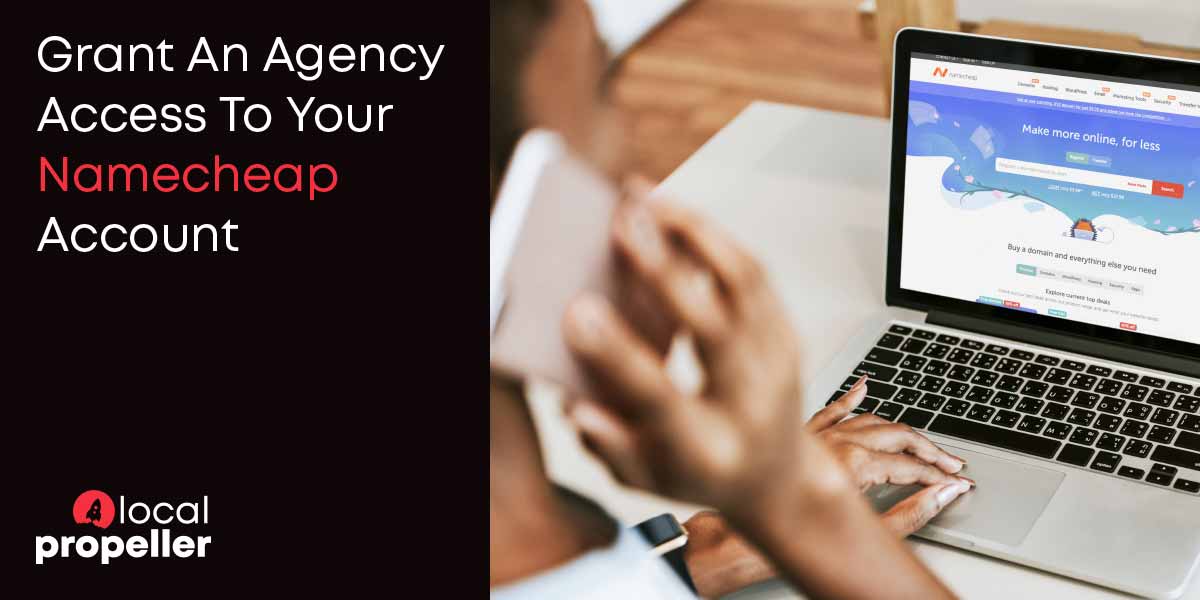Namecheap domain access, log in to your account and navigate to the “Domain List” section. Select your domain to manage settings.
Namecheap offers an intuitive platform for managing your domains with ease. Their user-friendly interface ensures you can quickly access and update your domain settings. Whether you need to change DNS records, update contact information, or renew your domain, everything is just a few clicks away.
Namecheap’s efficient system minimizes the time spent on administrative tasks, allowing you to focus on your business. Their comprehensive support resources, including tutorials and customer service, make domain management straightforward for both beginners and experienced users. With Namecheap, securing and maintaining your online presence is hassle-free and efficient.

Credit: www.namecheap.com
Introduction To Namecheap
Welcome to the world of Namecheap, a leading domain registration service. Namecheap offers a wide range of domain-related services. They provide affordable and reliable options for your online presence.
Company Background
Namecheap was founded in 2000 by Richard Kirkendall. Over the years, it has grown rapidly. Namecheap is known for its customer-centric approach. The company is headquartered in Phoenix, Arizona. They serve millions of customers worldwide. Namecheap has earned a reputation for trustworthiness and transparency.
Why Choose Namecheap
There are several reasons to choose Namecheap for your domain needs:
- Affordable Pricing: Namecheap offers competitive prices on domains.
- Customer Support: Their support team is available 24/7.
- Free WHOIS Privacy: Protect your personal information at no extra cost.
- Easy Management: Manage your domains with a user-friendly interface.
- Security: Namecheap provides robust security features.
Here’s a quick comparison table for Namecheap’s features:
| Feature | Details |
|---|---|
| Pricing | Affordable and transparent |
| Support | 24/7 customer service |
| Privacy | Free WHOIS privacy protection |
| Security | Advanced security features |
Choosing Namecheap means opting for reliability and ease. It’s a choice you can trust for your online presence.
Setting Up Your Domain
Setting up your domain with Namecheap is simple. This guide will help you navigate the process seamlessly. You’ll learn how to register a new domain and transfer an existing one. Follow these steps, and your domain will be ready in no time.
Registering A New Domain
To register a new domain, follow these steps:
- Go to the Namecheap website.
- Enter the domain name you want in the search bar.
- Click on the search button.
- Review the available options.
- Select the domain name you like.
- Click on the “Add to Cart” button.
- Go to your cart and proceed to checkout.
- Complete the payment process.
Transferring An Existing Domain
If you have an existing domain, follow these steps to transfer it:
- Log in to your current registrar.
- Unlock your domain name.
- Get the authorization code (EPP code).
- Go to the Namecheap website.
- Navigate to the “Transfer” section.
- Enter your domain name.
- Provide the authorization code.
- Click on the “Transfer” button.
- Complete the payment process.
Managing Domain Settings
Managing your domain settings with Namecheap is simple. This guide will help you with DNS configuration and email forwarding. Let’s dive into each section.
DNS Configuration
DNS configuration is crucial for your domain. It directs traffic to your website. Here’s a simple way to set it up:
- Login to your Namecheap account.
- Go to the Dashboard.
- Select the domain you want to manage.
- Click on Manage.
- Navigate to the Advanced DNS tab.
Here, you can add or edit DNS records:
- A Record: Points your domain to an IP address.
- MX Record: Directs email to your mail server.
- CNAME Record: Maps an alias name to a true name.
- TXT Record: Adds text to your domain.
Make sure to save your changes. Your DNS settings will update in a few minutes.
Setting Up Email Forwarding
Email forwarding is a great feature. It redirects emails from your domain to another email address. Follow these steps to set it up:
- Login to your Namecheap account.
- Go to the Dashboard.
- Select the domain you want to manage.
- Click on Manage.
- Navigate to the Email Forwarding tab.
Next, add a new email forward:
- Click on Add Forwarder.
- Enter the email address you want to forward from.
- Enter the destination email address.
- Click Save.
Your email forwarding is now set up. Emails sent to your domain will redirect to the specified address.
Integrating With Hosting
Integrating your Namecheap domain with a hosting plan is crucial. This ensures your website is live and accessible. Below, we explore how to choose the right hosting plan and connect your domain to hosting.
Choosing The Right Hosting Plan
Choosing the right hosting plan is essential. Namecheap offers various plans. These include shared hosting, VPS hosting, and dedicated servers. Each plan suits different needs. Here are some points to consider:
- Shared Hosting: Ideal for small websites or blogs.
- VPS Hosting: Perfect for medium-sized businesses.
- Dedicated Servers: Best for large enterprises.
Consider your website’s traffic. Small sites can use shared hosting. High-traffic sites need VPS or dedicated servers.
Connecting Your Domain To Hosting
Connecting your domain to hosting is simple. Follow these steps:
- Log in to your Namecheap account.
- Go to the Domain List tab.
- Click Manage next to your domain.
- Select the Advanced DNS tab.
- Update the Nameservers to your hosting provider’s details.
Wait for DNS propagation. This can take up to 48 hours. Once complete, your domain will point to your hosting.
| Hosting Type | Recommended For |
|---|---|
| Shared Hosting | Small websites, blogs |
| VPS Hosting | Medium-sized businesses |
| Dedicated Servers | Large enterprises |
Namecheap Security Features
Ensuring the security of your domain is crucial. Namecheap provides robust security features. These features protect your domain from various threats. Below are some key security measures offered by Namecheap.
SSL Certificates
An SSL Certificate secures your website. It encrypts the data between the server and the user. This ensures that sensitive information remains safe. Namecheap offers a variety of SSL certificates. They have options for every type of website. You can choose from:
- Single Domain SSL – Protects one domain.
- Wildcard SSL – Secures your domain and all subdomains.
- Multi-Domain SSL – Covers multiple domains with one certificate.
An SSL certificate also boosts your search engine rankings. Google favors websites with SSL encryption. So, securing your domain with SSL is essential.
Domain Privacy Protection
Domain Privacy Protection hides your personal information. When you register a domain, your details become public. This can lead to spam and unwanted contact. Namecheap’s Domain Privacy Protection service keeps your information private. Here are some benefits:
- Prevents Spam – Your email address stays hidden.
- Protects Identity – Keeps your contact details confidential.
- Enhances Security – Reduces the risk of identity theft.
This service is free for the first year with Namecheap. After that, it is affordable to renew. This makes it easy to keep your information safe.

Credit: www.namecheap.com
Renewing And Expiring Domains
Managing your domain’s lifecycle is crucial for your online presence. Ensuring your domain doesn’t expire keeps your website accessible. Namecheap offers several tools to help you with this.
Auto-renewal Options
With Namecheap, you can enable auto-renewal for your domains. This ensures your domain renews before it expires. Auto-renewal helps you avoid losing your domain. You can enable or disable this option anytime in your account settings.
- Log in to your Namecheap account.
- Go to the “Domain List” section.
- Select the domain you want to auto-renew.
- Toggle the auto-renewal switch to “On”.
This simple process keeps your domain active without manual intervention. It’s a set-it-and-forget-it solution for busy website owners.
Handling Expired Domains
If your domain expires, you still have options to recover it. Namecheap provides a grace period after expiration. During this time, you can renew the domain without extra costs.
| Grace Period | Actions |
|---|---|
| 0-30 days | Renew domain at regular cost |
| 31-60 days | Renew the domain with a redemption fee |
After the grace period, the domain enters the redemption phase. Renewing during this phase incurs additional costs. Act promptly to avoid losing your domain permanently.
- Log in to your Namecheap account.
- Navigate to the “Expired Domains” section.
- Select the domain you want to renew.
- Follow the prompts to complete the renewal.
By following these steps, you can manage expired domains effectively. This keeps your website running smoothly and uninterrupted.
Troubleshooting Common Issues
Experiencing issues with your Namecheap domain access can be frustrating. This section will help you troubleshoot common problems. Here, you will find solutions to DNS propagation delays and email setup problems.
DNS Propagation Delays
DNS propagation delays are a common issue. This usually occurs after updating DNS settings. Propagation can take up to 48 hours. Here are some steps to check your DNS status:
- Use online DNS check tools.
- Clear your browser cache.
- Flush your DNS cache.
Follow these steps to flush your DNS cache:
- Open the command prompt.
- Type
ipconfig /flushdnsand press Enter. - Restart your browser.
Patience is key. DNS changes need time to propagate globally.
Email Setup Problems
Email setup problems often stem from incorrect settings. Verify your email settings first. Here is a quick checklist:
| Setting | Value |
|---|---|
| Incoming Mail Server | mail.yourdomain.com |
| Outgoing Mail Server | mail.yourdomain.com |
| Username | Your full email address |
| Password | Your email password |
| Port | IMAP: 993, SMTP: 587 |
Make sure to enable SSL/TLS for security. If issues persist, contact Namecheap support. They provide excellent assistance.
Advanced Tools And Resources
Using Namecheap for domain management provides several advanced tools and resources. These tools make domain management easier for all users.
API Access
API access is crucial for developers. It allows seamless integration with other systems. Namecheap offers a robust API for domain management. With this API, you can perform many tasks:
- Register new domains
- Renew existing domains
- Update domain contact information
- Manage DNS settings
Access to the API is secure and reliable. It supports various programming languages. This flexibility makes it ideal for diverse projects.
Third-party Integrations
Third-party integrations enhance the functionality of your domain. Namecheap supports several tools and platforms. These integrations can save you time and effort. Here are some popular integrations:
| Tool/Platform | Function |
|---|---|
| WordPress | Easy website creation and management |
| Google Workspace | Professional email and productivity tools |
| Shopify | Seamless e-commerce setup |
Integrating these tools is straightforward. Namecheap provides detailed guides for each integration. This ensures you can set up everything without hassle.
Customer Support
Customer support is crucial for any service, including domain access. Namecheap offers reliable customer support to ensure smooth user experiences. Below, we will explore the various aspects of their customer support services.
Contact Methods
Namecheap provides multiple ways to reach their support team:
- Live Chat: Immediate assistance through their website.
- Email Support: Send detailed queries via email.
- Help Center: Extensive articles and FAQs.
- Community Forum: Engage with other users and experts.
Response Time Expectations
| Contact Method | Expected Response Time |
|---|---|
| Live Chat | Within minutes |
| Email Support | Within 24 hours |
| Help Center | Instant Access |
| Community Forum | Varies |
Live Chat provides the fastest support. Email support is for detailed queries. The Help Center offers instant information. The Community Forum has variable response times based on user activity.

Credit: localpropeller.ca
Frequently Asked Questions
How To Access Namecheap Domain?
Log in to your Namecheap account. Navigate to “Domain List” under the “Dashboard” menu. Select your domain.
Can I Give Access To My Namecheap Account?
Yes, you can grant access to your Namecheap account. Use the “Share Access” feature to do this securely.
How Do I Give Domain Access To Someone Else?
To give domain access, log into your domain registrar account, find the domain settings, and select “Manage Users. ” Add the person’s email and set permissions.
How To Unlock A Namecheap Domain?
Log in to your Namecheap account. Go to “Domain List. ” Click “Manage” next to the domain. Toggle off the Registrar Lock.
How Do I Access My Namecheap Domain?
Log in to Namecheap, go to ‘Domain List’, and click ‘Manage’ next to your domain.
Can I Transfer My Domain To Namecheap?
Yes, initiate the transfer by unlocking your domain and obtaining the EPP code from your current registrar.
Conclusion
Choosing Namecheap for domain access ensures reliability and affordability. Their user-friendly interface makes managing domains easy. Enjoy excellent customer support and numerous features. Namecheap remains a top choice for businesses and individuals. Start your online journey with confidence by selecting Namecheap for your domain needs.








